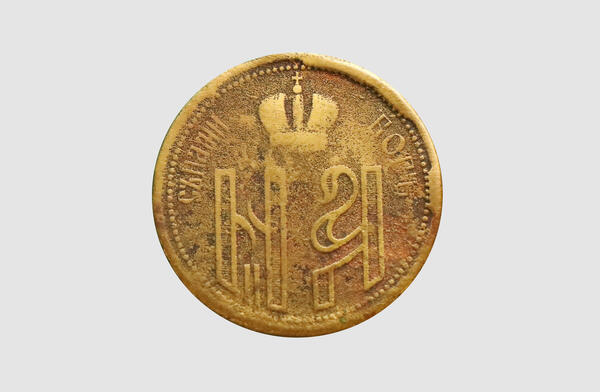The pendant is minted from bronze in 1896–1898. The diameter of this copy in the Numismatics collection is 25 mm. The metal has grown dark with time and the item itself is very worn.
The coronation of Emperor Nikolas the Second was the last coronation the Russian Empire saw. It was celebrated on Tuesday, May 14, 1896, at the Dormition Cathedral of the Moscow Kremlin. However, preparations for this day, very important for the whole country, started long before. One of the aspects was making commemorative pendants, medals, and coins. In June 1895, the medal sculptor Anton Vasyutkin presented his sketches of the coronation medals, pendants, and rubles. Nikolas II didn’t like them and rejected the first project. He ordered to make the tail side the same as on the coronation medals of his late father, later Emperor Alexander III, and make them of the same type, size, and weight.
All days from May 6 until May 26 of 1896 were announced the coronation period. On May 25 the country celebrated Empress Alexandra Feodorovna’s birthday. On May 14, 1896, 100 collections of four medals and two pendants each, and 170 large golden medals were given away during the feast at the Faceted Chamber. Apart from medals, each collection also contained a silver coronation pendant. Such pendants were also distributed among the common folk. After the coronation festivities were over, anyone could buy medals and pendants from the metal of choice, including bronze now, at the Saint Petersburg Mint.
The commemorative pendant in the collection of the Mytishchi History and Art Museum was minted from light bronze suggesting it was made at the request of a ministry to be distributed among common people. On the obverse, the head side, there is an image of a crown and the phrase ‘Crowned in Moscow in 1896.’ On the reverse, the tail side, we see an image of a crown and the phrase ‘God Is With Us’ and the initials ‘N II A.’ During the Revolution of 1917, having such pendants in one’s possessions was frowned upon, so people normally hid them. Today these pendants are very rare and have high historical and cultural value.
The coronation of Emperor Nikolas the Second was the last coronation the Russian Empire saw. It was celebrated on Tuesday, May 14, 1896, at the Dormition Cathedral of the Moscow Kremlin. However, preparations for this day, very important for the whole country, started long before. One of the aspects was making commemorative pendants, medals, and coins. In June 1895, the medal sculptor Anton Vasyutkin presented his sketches of the coronation medals, pendants, and rubles. Nikolas II didn’t like them and rejected the first project. He ordered to make the tail side the same as on the coronation medals of his late father, later Emperor Alexander III, and make them of the same type, size, and weight.
All days from May 6 until May 26 of 1896 were announced the coronation period. On May 25 the country celebrated Empress Alexandra Feodorovna’s birthday. On May 14, 1896, 100 collections of four medals and two pendants each, and 170 large golden medals were given away during the feast at the Faceted Chamber. Apart from medals, each collection also contained a silver coronation pendant. Such pendants were also distributed among the common folk. After the coronation festivities were over, anyone could buy medals and pendants from the metal of choice, including bronze now, at the Saint Petersburg Mint.
The commemorative pendant in the collection of the Mytishchi History and Art Museum was minted from light bronze suggesting it was made at the request of a ministry to be distributed among common people. On the obverse, the head side, there is an image of a crown and the phrase ‘Crowned in Moscow in 1896.’ On the reverse, the tail side, we see an image of a crown and the phrase ‘God Is With Us’ and the initials ‘N II A.’ During the Revolution of 1917, having such pendants in one’s possessions was frowned upon, so people normally hid them. Today these pendants are very rare and have high historical and cultural value.



